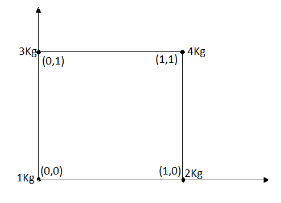
Four particles of masses 1kg, 2kg, 3kg and 4kg respectively are located at the corners of a square of 1 m side. If 1 kg is taken at the origin, 2kg and 3 kg are on x and y axes then the coordinates of centre of mass are
A. (0.4m,0.5m)
B. (0.5m,0.7m)
C. (0.5m,0.6m)
D. (0.6m,0.7m)
Answer
550.5k+ views
Hint: Firstly, we write the coordinates for all the four particles given in the question. To find the centre of mass of these particles we multiply the mass of each particle$\left( {{m}_{i}} \right)$ with the respective position$\left( {{r}_{i}} \right)$ and then sum of up. Dividing the sum with the overall sum of individual masses of the particle, we get the centre of mass.
Complete step by step answer:
Let us write the coordinates of all the particles.

The coordinate of mass 1kg is, mass 2kg is, mass 3 kg is and mass 4 kg is (0,0), (1,0), (0,1) and (1,1) respectively.
The centre of mass for a system of particle is given by the formula:
\[{{r}_{com}}=\dfrac{\sum\limits_{i=1}^{n}{{{m}_{i}}{{r}_{i}}}}{\sum\limits_{i=1}^{n}{{{m}_{i}}}}\],
where $\left( {{m}_{i}} \right)$ represent mass of each particle and$\left( {{r}_{i}} \right)$ represents the position of each particle.
So, the x-coordinate for the centre of mass can be given by:
${{x}_{com}}=\dfrac{\sum\limits_{i=1}^{n}{{{m}_{i}}{{x}_{i}}}}{\sum\limits_{i=1}^{n}{{{m}_{i}}}}$
$\Rightarrow {{x}_{com}}=\dfrac{1\times 0+2\times 1+3\times 0+4\times 1}{1+2+3+4}$
$\Rightarrow \dfrac{6}{10}$
$\therefore 0.6m$
The y coordinate for the centre of mass is
${{y}_{com}}=\dfrac{\sum\limits_{i=1}^{n}{{{m}_{i}}{{y}_{i}}}}{\sum\limits_{i=1}^{n}{{{m}_{i}}}}$
$\Rightarrow {{y}_{com}}=\dfrac{1\times 0+2\times 0+3\times 1+4\times 1}{1+2+3+4}$
$\Rightarrow {{y}_{com}} =\dfrac{7}{10}$
$\therefore {{y}_{com}} = 0.7m$
Therefore, the coordinates for the centre of mass for the system of particles is (0.6m, 0.7m).
So, the correct option is D.
Note: One should know the general formula of centre of mass, \[{{r}_{com}}=\dfrac{\sum\limits_{i=1}^{n}{{{m}_{i}}{{r}_{i}}}}{\sum\limits_{i=1}^{n}{{{m}_{i}}}}\],
where $\left( {{m}_{i}} \right)$ represent mass of each particle and$\left( {{r}_{i}} \right)$ represents the position of each particle.
Centre of mass for a system of particles can be defined as a point where the whole mass of the system can be assumed to be concentrated, which produces the same acceleration as the system when the same force is applied on them. It is one of the most important quantities when we work with rigid bodies or a collection of particles.
Complete step by step answer:
Let us write the coordinates of all the particles.

The coordinate of mass 1kg is, mass 2kg is, mass 3 kg is and mass 4 kg is (0,0), (1,0), (0,1) and (1,1) respectively.
The centre of mass for a system of particle is given by the formula:
\[{{r}_{com}}=\dfrac{\sum\limits_{i=1}^{n}{{{m}_{i}}{{r}_{i}}}}{\sum\limits_{i=1}^{n}{{{m}_{i}}}}\],
where $\left( {{m}_{i}} \right)$ represent mass of each particle and$\left( {{r}_{i}} \right)$ represents the position of each particle.
So, the x-coordinate for the centre of mass can be given by:
${{x}_{com}}=\dfrac{\sum\limits_{i=1}^{n}{{{m}_{i}}{{x}_{i}}}}{\sum\limits_{i=1}^{n}{{{m}_{i}}}}$
$\Rightarrow {{x}_{com}}=\dfrac{1\times 0+2\times 1+3\times 0+4\times 1}{1+2+3+4}$
$\Rightarrow \dfrac{6}{10}$
$\therefore 0.6m$
The y coordinate for the centre of mass is
${{y}_{com}}=\dfrac{\sum\limits_{i=1}^{n}{{{m}_{i}}{{y}_{i}}}}{\sum\limits_{i=1}^{n}{{{m}_{i}}}}$
$\Rightarrow {{y}_{com}}=\dfrac{1\times 0+2\times 0+3\times 1+4\times 1}{1+2+3+4}$
$\Rightarrow {{y}_{com}} =\dfrac{7}{10}$
$\therefore {{y}_{com}} = 0.7m$
Therefore, the coordinates for the centre of mass for the system of particles is (0.6m, 0.7m).
So, the correct option is D.
Note: One should know the general formula of centre of mass, \[{{r}_{com}}=\dfrac{\sum\limits_{i=1}^{n}{{{m}_{i}}{{r}_{i}}}}{\sum\limits_{i=1}^{n}{{{m}_{i}}}}\],
where $\left( {{m}_{i}} \right)$ represent mass of each particle and$\left( {{r}_{i}} \right)$ represents the position of each particle.
Centre of mass for a system of particles can be defined as a point where the whole mass of the system can be assumed to be concentrated, which produces the same acceleration as the system when the same force is applied on them. It is one of the most important quantities when we work with rigid bodies or a collection of particles.
Recently Updated Pages
Why are manures considered better than fertilizers class 11 biology CBSE

Find the coordinates of the midpoint of the line segment class 11 maths CBSE

Distinguish between static friction limiting friction class 11 physics CBSE

The Chairman of the constituent Assembly was A Jawaharlal class 11 social science CBSE

The first National Commission on Labour NCL submitted class 11 social science CBSE

Number of all subshell of n + l 7 is A 4 B 5 C 6 D class 11 chemistry CBSE

Trending doubts
Differentiate between an exothermic and an endothermic class 11 chemistry CBSE

10 examples of friction in our daily life

One Metric ton is equal to kg A 10000 B 1000 C 100 class 11 physics CBSE

Difference Between Prokaryotic Cells and Eukaryotic Cells

State the laws of reflection of light

Explain zero factorial class 11 maths CBSE




